formerly eScholarship Editions


|
|
|
|
Your request for similar items found 20 book(s). | Modify Search | Displaying 1 - 20 of 20 book(s) | |
| 1. | 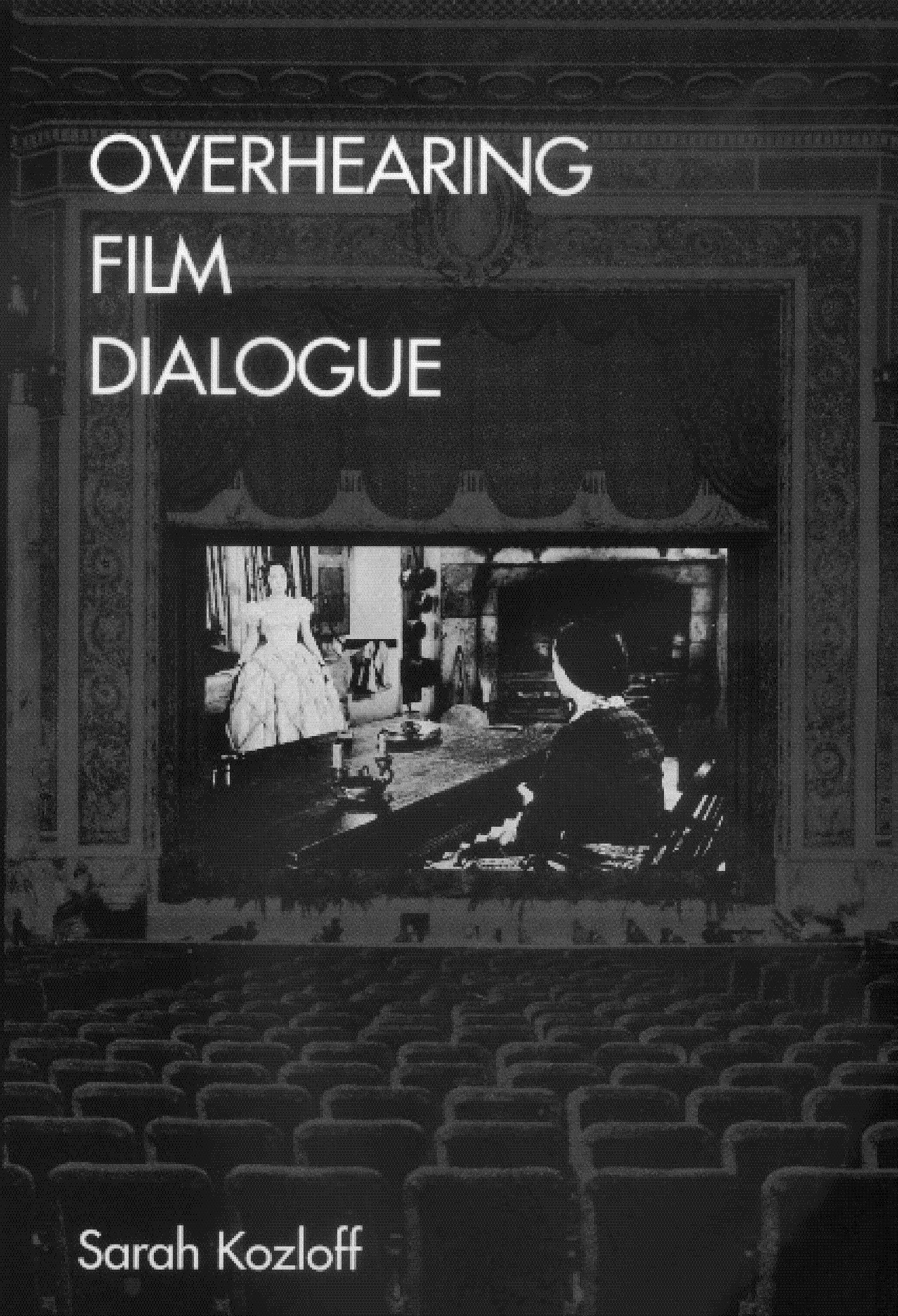 | Title: Overhearing film dialogue Author: Kozloff, Sarah Published: University of California Press, 2000 Subjects: Cinema and Performance Arts | Literary Theory and Criticism | American Studies | Film Publisher's Description: Since the birth of cinema, film has been lauded as a visual rather than a verbal medium; this sentiment was epitomized by John Ford's assertion in 1964 that, "When a motion picture is at its best, it is long on action and short on dialogue." Little serious work has been done on the subject of film dialogue, yet what characters say and how they say it has been crucial to our experience and understanding of every film since the coming of sound. Through informative discussions of dozens of classic and contemporary films - from Bringing Up Baby to Terms of Endearment, from Stagecoach to Reservoir Dogs --this lively book provides the first full-length study of the use of dialogue in American film. Sarah Kozloff shows why dialogue has been neglected in the analysis of narrative film and uncovers the essential contributions dialogue makes to a film's development and impact. She uses narrative theory and drama theory to analyze the functions that dialogue typically serves in a film. The second part of the book is a comprehensive discussion of the role and nature of dialogue in four film genres: westerns, screwball comedies, gangster films, and melodramas. Focusing on topics such as class and ethnic dialects, censorship, and the effect of dramatic irony, Kozloff provides an illuminating new perspective on film genres. [brief] Similar Items |
| 2. | 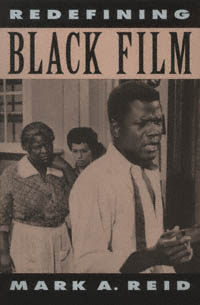 | Title: Redefining Black film Author: Reid, Mark (Mark A.) Published: University of California Press, 1993 Subjects: Cinema and Performance Arts | Film | African American Studies Publisher's Description: Can films about black characters, produced by white filmmakers, be considered "black films"? In answering this question, Mark Reid reassesses black film history, carefully distinguishing between films controlled by blacks and films that utilize black talent, but are controlled by whites. Previous black film criticism has "buried" the true black film industry, Reid says, by concentrating on films that are about, but not by, blacks.Reid's discussion of black independent films - defined as films that focus on the black community and that are written, directed, produced, and distributed by blacks - ranges from the earliest black involvement at the turn of the century up through the civil rights movement of the Sixties and the recent resurgence of feminism in black cultural production. His critical assessment of work by some black filmmakers such as Spike Lee notes how these films avoid dramatizations of sexism, homophobia, and classism within the black community.In the area of black commercial film controlled by whites, Reid considers three genres: African-American comedy, black family film, and black action film. He points out that even when these films use black writers and directors, a black perspective rarely surfaces.Reid's innovative critical approach, which transcends the "black-image" language of earlier studies - and at the same time redefines black film - makes an important contribution to film history. Certain to attract film scholars, this work will also appeal to anyone interested in African-American and Women's Studies. [brief] Similar Items |
| 3. | 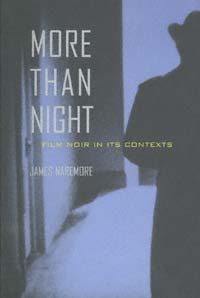 | Title: More than night: film noir in its contexts Author: Naremore, James Published: University of California Press, 1998 Subjects: Cinema and Performance Arts | Film | Literature Publisher's Description: "Film noir" evokes memories of stylish, cynical, black-and-white movies from the 1940s and 1950s - melodramas about private eyes, femmes fatales, criminal gangs, and lovers on the run. In More Than Night , James Naremore discusses these pictures, but he also shows that the central term is more complex and paradoxical than we realize. Film noir refers both to an important cinematic legacy and to an idea we have projected onto the past.This lively, wide-ranging cultural history offers an original approach to the subject, as well as new production information and fresh commentary on scores of films, including such classics as Double Indemnity , The Third Man , and Out of the Past , and such "neo noirs" as Chinatown , Pulp Fiction , and Devil in a Blue Dress . Naremore discusses film noir as a term in criticism; as an expression of artistic modernism; as a symptom of Hollywood censorship and politics in the 1940s; as a market strategy; as an evolving style; as a cinema about races and nationalities; and as an idea that circulates across all the information technologies. Interdisciplinary in approach, this book has valuable things to say not only about film and television, but also about modern literature, the fine arts, and popular culture in general. In a field where much of what has been published is superficial and derivative, Naremore's work is certain to be received as a definitive treatment. [brief] Similar Items |
| 4. | 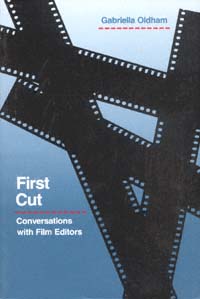 | Title: First cut: conversations with film editors Author: Oldham, Gabriella Published: University of California Press, 1992 Subjects: Cinema and Performance Arts | Film | Media Studies Publisher's Description: First Cut offers an opportunity to learn what film editing really is, and to learn from the source. Gabriella Oldham's interviews with twenty-three award-winning film editors give a full picture of the complex art and craft of editing a film. Filled with animated anecdotes and detailed examples, thi . . . [more] Similar Items |
| 5. | 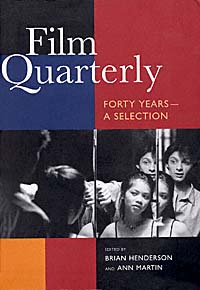 | Title: Film quarterly: forty years--a selection Author: Henderson, Brian Published: University of California Press, 1999 Subjects: Cinema and Performance Arts | Film Publisher's Description: During its forty years as a forum for scholars, filmmakers, critics, and film lovers, Film Quarterly has looked in depth at the most critical elements in the political, social, theoretical, and aesthetic history of the cinema. Once closely tied to Hollywood, the journal was investigated by the Tenney committee in 1946 and two of its board members came under fire from the House Un-American Activities Committee in 1951. After several metamorphoses, however, and with the dedicated participation of its editors, board members, and authors, the journal now stands as the oldest and most prominent journal in cinema studies, publishing film (and video and television) history, criticism, theory, analysis, interviews, and film and book reviews.Spanning the 1950s to the 1990s, Film Quarterly: Forty Years - A Selection is a collaborative effort by the past and present editors and the editorial board to celebrate and illuminate the medium that has prompted so much thought and exchange during the journal's lifetime. From articles on documentary and genre to history and technology, narrative and the avant-garde, this carefully selected collection proposes groundbreaking theoretical models, fresh approaches to individual film classics, reassessments of filmmakers' bodies of work, and discussions of new films and technologies. [brief] Similar Items |
| 6. | 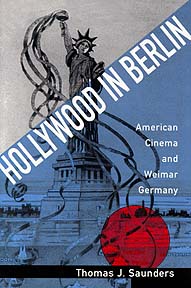 | Title: Hollywood in Berlin: American cinema and Weimar Germany Author: Saunders, Thomas J Published: University of California Press, 1994 Subjects: Cinema and Performance Arts | German Studies | Film | United States History | European History Publisher's Description: The setting is 1920s Berlin, cultural heart of Europe and the era's only serious cinematic rival to Hollywood. In his engaging study, Thomas Saunders explores an outstanding example of one of the most important cultural developments of this century: global Americanization through the motion picture.The invasion of Germany by American films, which began in 1921 with overlapping waves of sensationalist serials, slapstick shorts, society pictures, and historical epics, initiated a decade of cultural collision and accommodation. On the one hand it fueled an impassioned debate about the properties of cinema and the specter of wholesale Americanization. On the other hand it spawned unprecedented levels of cooperation and exchange.In Berlin, American motion pictures not only entertained all social classes and film tastes but also served as a vehicle for American values and a source of sharp economic competition. Hollywood in Berlin correlates the changing forms of Hollywood's contributions to Weimar culture and the discourses that framed and interpreted them, restoring historical contours to a leading aspect of cultural interchange in this century. At the same time, the book successfully embeds Weimar cinema in its contemporary international setting. [brief] Similar Items |
| 7. | 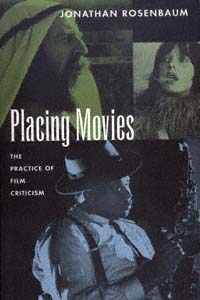 | Title: Placing movies: the practice of film criticism Author: Rosenbaum, Jonathan Published: University of California Press, 1995 Subjects: Cinema and Performance Arts | Film Publisher's Description: Jonathan Rosenbaum, longtime contributor to such publications as Film Quarterly, Sight and Sound, and The Village Voice , is arguably the most eloquent, insightful film critic writing in America today. Placing Movies , the first collection of his work, gathers together thirty of his most distinctive and illuminating pieces. Written over a span of twenty-one years, these essays cover an extraordinarily broad range of films - from Hollywood blockbusters to foreign art movies to experimental cinema. They include not just reviews but perceptive commentary on directors, actors, and trends; and thoughtful analysis of the practice of film criticism.It is this last element - Rosenbaum's reflections on the art of film criticism - that sets this collection apart from other volumes of film writing. Both in the essays themselves and in the section introductions, Rosenbaum provides a rare insider's view of his profession: the backstage politics, the formulation of critical judgments, the function of film commentary. Taken together, these pieces serve as a guided tour of the profession of film criticism.They also serve as representative samples of Rosenbaum's unique brand of film writing. Among the highlights are memoirs of director Jacques Tati and maverick critic Manny Farber, celebrations of classics such as Gentlemen Prefer Blondes and The Manchurian Candidate , and considered reevaluations of Orson Welles and Woody Allen. [brief] Similar Items |
| 8. | 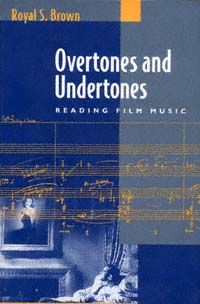 | Title: Overtones and undertones: reading film music Author: Brown, Royal S Published: University of California Press, 1994 Subjects: Cinema and Performance Arts | Film | Music Publisher's Description: Since the days of silent films, music has been integral to the cinematic experience, serving, variously, to allay audiences' fears of the dark and to heighten a film's emotional impact. Yet viewers are often unaware of its presence. In this bold, insightful book, film and music scholar and critic Royal S. Brown invites readers not only to "hear" the film score, but to understand it in relation to what they "see."Unlike earlier books, which offered historical, technical, and sociopolitical analyses, Overtones and Undertones draws on film, music, and narrative theory to provide the first comprehensive aesthetics of film music. Focusing on how the film/score interaction influences our response to cinematic situations, Brown traces the history of film music from its beginnings, covering both American and European cinema. At the heart of his book are close readings of several of the best film/score interactions, including Psycho, Laura, The Sea Hawk, Double Indemnity, and Pierrot le Fou. In revealing interviews with Bernard Herrmann, Miklós Rósza, Henry Mancini, and others, Brown also allows the composers to speak for themselves. A complete discography and bibliography conclude the volume. [brief] Similar Items |
| 9. | 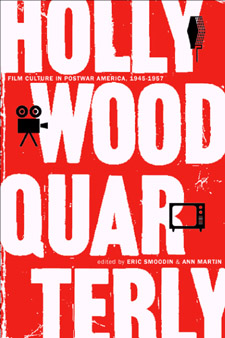 | Title: Hollywood quarterly: film culture in postwar America, 1945-1957 Author: Smoodin, Eric Loren Published: University of California Press, 2002 Subjects: Cinema and Performance Arts Publisher's Description: The first issue of Hollywood Quarterly, in October 1945, marked the appearance of the most significant, successful, and regularly published journal of its kind in the United States. For its entire life, the Quarterly held to the leftist utopianism of its founders, several of whom would later be blacklisted. The journal attracted a collection of writers unmatched in North American film studies for the heterogeneity of their intellectual and practical concerns: from film, radio, and television industry workers to academics; from Sam Goldwyn, Edith Head, and Chuck Jones to Theodor Adorno and Siegfried Kracauer. For this volume, Eric Smoodin and Ann Martin have selected essays that reflect the astonishing eclecticism of the journal, with sections on animation, the avant-garde, and documentary to go along with a representative sampling of articles about feature-length narrative films. They have also included articles on radio and television, reflecting the contents of just about every issue of the journal and exemplifying the extraordinary moment in film and media studies that Hollywood Quarterly captured and helped to create. In 1951, Hollywood Quarterly was renamed the Quarterly of Film, Radio, and Television, and in 1958 it was replaced by Film Quarterly, which is still published by the University of California Press. During those first twelve years, the Quarterly maintained an intelligent, sophisticated, and critical interest in all the major entertainment media, not just film, and in issue after issue insisted on the importance of both aesthetic and sociological methodologies for studying popular culture, and on the political significance of the mass media. [brief] Similar Items |
| 10. | 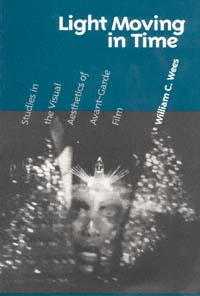 | Title: Light moving in time: studies in the visual aesthetics of avant-garde film Author: Wees, William C. (William Charles) 1935- Published: University of California Press, 1992 Subjects: Cinema and Performance Arts | Film Publisher's Description: To view a film is to see another's seeing mediated by the technology and techniques of the camera. By manipulating the cinematic apparatus in unorthodox ways, avant-garde filmmakers challenge the standardized versions of seeing perpetuated by the dominant film industry and generate ways of seeing that are truer to actual human vision.Beginning with the proposition that the images of cinema and vision derive from the same basic elements - light, movement, and time - Wees argues that cinematic apparatus and human visual apparatus have significant properties in common. For that reason they can be brought into a dynamic, creative relationship which the author calls the dialectic of eye and camera. The consequences of this relationship are what Wees explores.Although previous studies have recognized the visual bias of avant-garde film, this is the first to place the visual aesthetics of avant-garde film in a long-standing, multidisciplinary discourse on vision, visuality, and art. [brief] Similar Items |
| 11. | 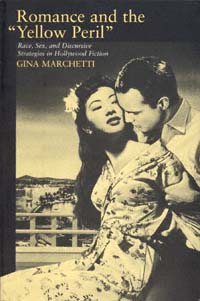 | Title: Romance and the "yellow peril": race, sex, and discursive strategies in Hollywood fiction Author: Marchetti, Gina Published: University of California Press, 1994 Subjects: Cinema and Performance Arts | Film | Women's Studies Publisher's Description: Hollywood films about Asians and interracial sexuality are the focus of Gina Marchetti's provocative new work. While miscegenation might seem an unlikely theme for Hollywood, Marchetti shows how fantasy-dramas of interracial rape, lynching, tragic love, and model marriage are powerfully evident in American cinema.The author begins with a discussion of D. W. Griffith's Broken Blossoms , then considers later films such as Shanghai Express , Madame Butterfly , and the recurring geisha movies. She also includes some fascinating "forgotten" films that have been overlooked by critics until now.Marchetti brings the theoretical perspective of recent writing on race, ethnicity, and gender to her analyses of film and television and argues persuasively that these media help to perpetuate social and racial inequality in America. Noting how social norms and taboos have been simultaneously set and broken by Hollywood filmmakers, she discusses the "orientalist" tensions underlying the construction of American cultural identity. Her book will be certain to interest readers in film, Asian, women's, and cultural studies. [brief] Similar Items |
| 12. | 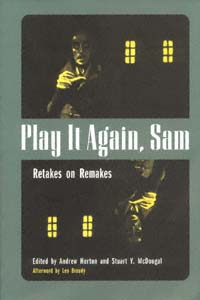 | Title: Play it again, Sam: retakes on remakes Author: Horton, Andrew Published: University of California Press, 1998 Subjects: Cinema and Performance Arts | Film Publisher's Description: Play It Again, Sam is a timely investigation of a topic that until now has received almost no critical attention in film and cultural studies: the cinematic remake. As cinema enters its second century, more remakes are appearing than ever before, and these writers consider the full range: Hollywood films that have been recycled by Hollywood, such as The Jazz Singer, Cape Fear , and Robin Hood ; foreign films including Breathless ; and Three Men and a Baby , which Hollywood has reworked for American audiences; and foreign films based on American works, among them Yugoslav director Emir Kusturica's Time of the Gypsies , which is a "makeover" of Coppola's Godfather films. As these essays demonstrate, films are remade by other films (Alfred Hitchcock went so far as to remake his own The Man Who Knew Too Much ) and by other media as well.The editors and contributors draw upon narrative, film, and cultural theories, and consider gender, genre, and psychological issues, presenting the "remake" as a special artistic form of repetition with a difference and as a commercial product aimed at profits in the marketplace. The remake flourishes at the crossroads of the old and the new, the known and the unknown. Play It Again, Sam takes the reader on an eye-opening tour of this hitherto unexplored territory. [brief] Similar Items |
| 13. | 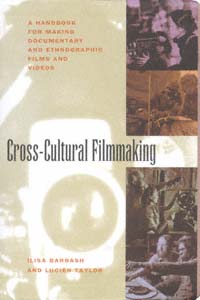 | Title: Cross-cultural filmmaking: a handbook for making documentary and ethnographic films and videos Author: Barbash, Ilisa 1959- Published: University of California Press, 1997 Subjects: Cinema and Performance Arts | Ethnic Studies | Photography Publisher's Description: This extraordinary handbook was inspired by the distinctive concerns of anthropologists and others who film people in the field. The authors cover the practical, technical, and theoretical aspects of filming, from fundraising to exhibition, in lucid and complete detail - information never before assembled in one place. The first section discusses filmmaking styles and the assumptions that frequently hide unacknowledged behind them, as well as the practical and ethical issues involved in moving from fieldwork to filmmaking. The second section concisely and clearly explains the technical aspects, including how to select and use equipment, how to shoot film and video, and the reasons for choosing one or the other, and how to record sound. Finally, the third section outlines the entire process of filmmaking: preproduction, production, postproduction, and distribution. Filled with useful illustrations and covering documentary and ethnographic filmmaking of all kinds, Cross-Cultural Filmmaking will be as essential to the anthropologist or independent documentarian on location as to the student in the classroom. [brief] Similar Items |
| 14. | 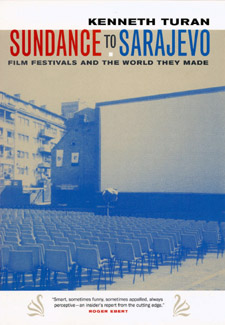 | Title: Sundance to Sarajevo: film festivals and the world they made Author: Turan, Kenneth Published: University of California Press, 2002 Subjects: Cinema and Performance Arts | Film Publisher's Description: Almost every day of the year a film festival takes place somewhere in the world--from sub-Saharan Africa to the Land of the Midnight Sun. Sundance to Sarajevo is a tour of the world's film festivals by an insider whose familiarity with the personalities, places, and culture surrounding the cinema makes him uniquely suited to his role. Kenneth Turan, film critic for the Los Angeles Times, writes about the most unusual as well as the most important film festivals, and the cities in which they occur, with an eye toward the larger picture. His lively narrative emphasizes the cultural, political, and sociological aspects of each event as well as the human stories that influence the various and telling ways the film world and the real world intersect. Of the festivals profiled in detail, Cannes and Sundance are obvious choices as the biggest, brashest, and most influential of the bunch. The others were selected for their ability to open a window onto a wider, more diverse world and cinema's place in it. Sometimes, as with Sarajevo and Havana, film is a vehicle for understanding the international political community's most vexing dilemmas. Sometimes, as with Burkina Faso's FESPACO and Pordenone's Giornate del Cinema Muto, it's a chance to examine the very nature of the cinematic experience. But always the stories in this book show us that film means more and touches deeper chords than anyone might have expected. No other book explores so many different festivals in such detail or provides a context beyond the merely cinematic. [brief] Similar Items |
| 15. | 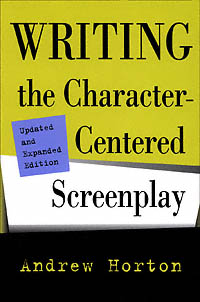 | Title: Writing the character-centered screenplay Author: Horton, Andrew Published: University of California Press, 1994 Subjects: Cinema and Performance Arts | Film | Writing Publisher's Description: "We need good screenwriters who understand character." Everywhere Andrew Horton traveled in researching this book - from Hollywood to Hungary - he heard the same refrain. Yet most of the standard how-to books on screenwriting follow the film industry's earlier lead in focusing almost exclusively on plot and formulaic structures.With this book, Horton, a film scholar and successful screenwriter, provides the definitive work on the character-based screenplay. Exceptionally wide-ranging - covering American, international, mainstream, and "off-Hollywood" films, as well as television - the book offers creative strategies and essential practical information.Horton begins by placing screenwriting in the context of the storytelling tradition, arguing through literary and cultural analysis that all great stories revolve around a strong central character. He then suggests specific techniques and concepts to help any writer - whether new or experienced - build more vivid characters and screenplays. Centering his discussion around four film examples - including Thelma & Louise and The Silence of the Lambs - and the television series, Northern Exposure , he takes the reader step-by-step through the screenwriting process, starting with the development of multi-dimensional characters and continuing through to rewrite. Finally, he includes a wealth of information about contests, fellowships, and film festivals.Espousing a new, character-based approach to screenwriting, this engaging, insightful work will prove an essential guide to all of those involved in the writing and development of film scripts. [brief] Similar Items |
| 16. | 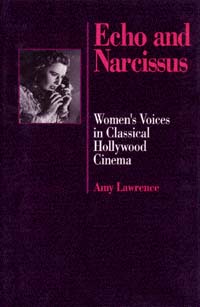 | Title: Echo and Narcissus: women's voices in classical Hollywood cinema Author: Lawrence, Amy Published: University of California Press, 1991 Subjects: Cinema and Performance Arts | Film | Women's Studies Publisher's Description: Do women in classical Hollywood cinema ever truly speak for themselves? In Echo and Narcissus , Amy Lawrence examines eight classic films to show how women's speech is repeatedly constructed as a "problem," an affront to male authority. This book expands feminist studies of the representation of women in film, enabling us to see individual films in new ways, and to ask new questions of other films.Using Sadie Thompson (1928), Blackmail (1929), Rain (1932), The Spiral Staircase , Sorry,Wrong Number , Notorious , Sunset Boulevard (1950) and To Kill a Mockingbird (1962), Lawrence illustrates how women's voices are positioned within narratives that require their submission to patriarchal roles and how their attempts to speak provoke increasingly severe repression. She also shows how women's natural ability to speak is interrupted, made difficult, or conditioned to a suffocating degree by sound technology itself. Telephones, phonographs, voice-overs, and dubbing are foregrounded, called upon to silence women and to restore the primacy of the image.Unlike the usage of "voice" by feminist and literary critics to discuss broad issues of authorship and point of view, in film studies the physical voice itself is a primary focus. Echo and Narcissus shows how assumptions about the "deficiencies" of women's voices and speech are embedded in sound's history, technology, uses, and marketing. Moreover, the construction of the woman's voice is inserted into the ideologically loaded cinematic and narrative conventions governing the representation of women in Hollywood film. [brief] Similar Items |
| 17. | 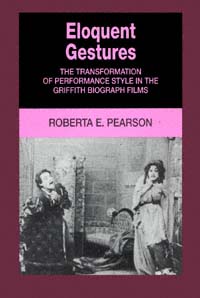 | Title: Eloquent gestures: the transformation of performance style in the Griffith Biograph films Author: Pearson, Roberta E Published: University of California Press, 1992 Subjects: Cinema and Performance Arts | Film Publisher's Description: Between 1908 and 1913, D. W. Griffith played a key role in the reformulating of film's narrative techniques, thus contributing to the creation of what we now think of as the classical Hollywood cinema. This book is the only extensive treatment of a critical period in the history of film acting: the emergence of the realistic "verisimilar" style in Griffith's biograph films. Roberta Pearson shows how Griffith gradually abandoned the deliberately affected "histrionic" acting style derived from the nineteenth-century stage. No longer did actors mime distress by raising their arms to heaven or clutching their heads - a subtle facial expression, a slight change in posture would convey a character's extreme emotions instead.Pearson makes detailed comparisons of certain Biograph films and brings a freshness to her analysis by closely examining contemporary journalistic writing, acting manuals, and the recollections of actors of the time. Her work is important for anyone interested in early cinema and performance, and it will enliven the study of American cultural history and mass communications. [brief] Similar Items |
| 18. | 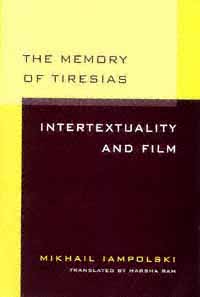 | Title: The memory of Tiresias: intertextuality and film Author: I︠A︡mpolʹskiĭ, M. B Published: University of California Press, 1998 Subjects: Cinema and Performance Arts | Literature | Popular Culture Publisher's Description: The concept of intertextuality has proven of inestimable value in recent attempts to understand the nature of literature and its relation to other systems of cultural meaning. In The Memory of Tiresias , Mikhail Iamposlki presents the first sustained attempt to develop a theory of cinematic intertextuality.Building on the insights of semiotics and contemporary film theory, Iampolski defines cinema as a chain of transparent, mimetic fragments intermixed with quotations he calls "textual anomalies." These challenge the normalization of meaning and seek to open reading out onto the unlimited field of cultural history, which is understood in texts as a semiotically active extract, already inscribed.Quotations obstruct mimesis and are consequently transformed in the process of semiosis, an operation that Iampolski defines as reading in an aura of enigma. In a series of brilliant analyses of films by D.W. Griffith, Sergei Eisenstein, and Luis Buñuel, he presents different strategies of intertextual reading in their work. His book suggests the continuing centrality of semiotic analysis and is certain to interest film historians and theorists, as well as readers in cultural and literary studies. [brief] Similar Items |
| 19. | 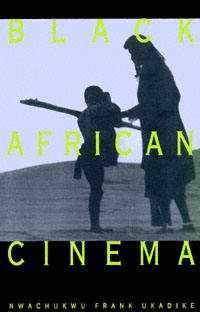 | Title: Black African cinema Author: Ukadike, Nwachukwu Frank Published: University of California Press, 1994 Subjects: Cinema and Performance Arts | Film Publisher's Description: From the proselytizing lantern slides of early Christian missionaries to contemporary films that look at Africa through an African lens, N. Frank Ukadike explores the development of black African cinema. He examines the impact of culture and history, and of technology and co-production, on filmmaking throughout Africa.Every aspect of African contact with and contribution to cinematic practices receives attention: British colonial cinema; the thematic and stylistic diversity of the pioneering "francophone" films; the effects of television on the motion picture industry; and patterns of television documentary filmmaking in "anglophone" regions. Ukadike gives special attention to the growth of independent production in Ghana and Nigeria, the unique Yoruba theater-film tradition, and the militant liberationist tendencies of "lusophone" filmmakers. He offers a lucid discussion of oral tradition as a creative matrix and the relationship between cinema and other forms of popular culture. And, by contrasting "new" African films with those based on the traditional paradigm, he explores the trends emerging from the eighties and nineties.Clearly written and accessible to specialist and general reader alike, Black African Cinema 's analysis of key films and issues - the most comprehensive in English - is unique. The book's pan-Africanist vision heralds important new strategies for appraising a cinema that increasingly attracts the attention of film students and Africanists. [brief] Similar Items |
| 20. | 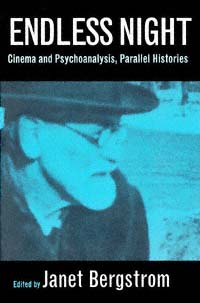 | Title: Endless night: cinema and psychoanalysis, parallel histories Author: Bergstrom, Janet 1946- Published: University of California Press, 1999 Subjects: Cinema and Performance Arts | Art Theory | Psychology Publisher's Description: The "endless night" that film theory and psychoanalysis share is the darkness that these two disciplines face in their quest for the logics of intelligibility. This collection emphasizes the history of theory to demonstrate that film theory must be written with a strong sense of historical consciousness, curiosity, and archaeological craft. The volume brings together film theorists and practicing psychoanalysts to encourage an exchange of views between disciplines that encounter each other all too rarely. [brief] Similar Items |